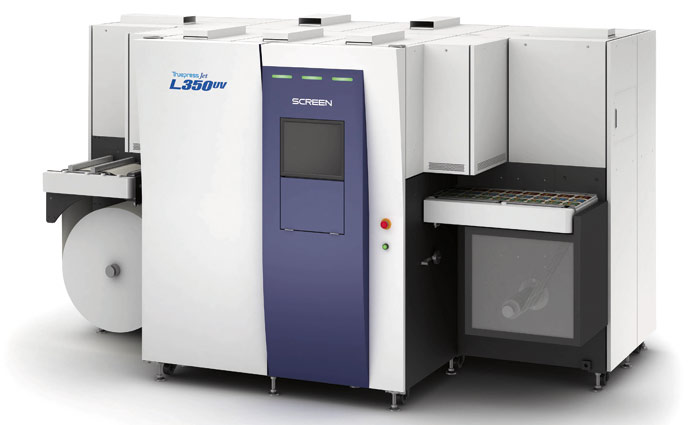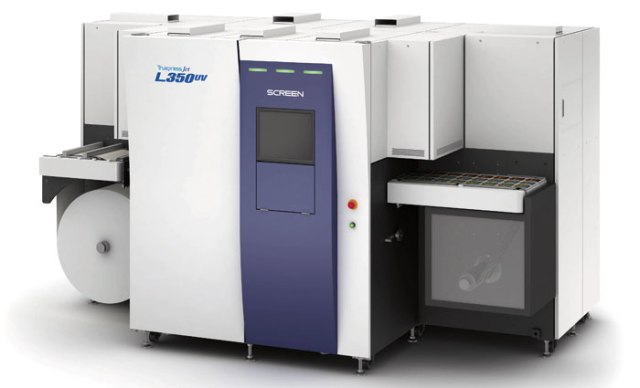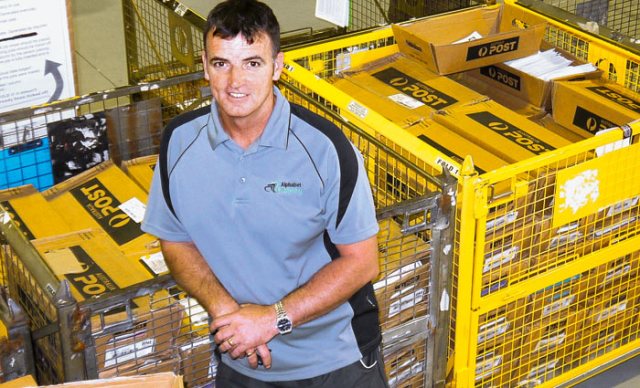
By 2015, a whopping 43% of all new label presses sold will be digital, according to research conducted by IT Strategies Inc. This will be largely driven by fast-moving consumer goods (FMCG) companies and major brands looking to produce value-added packaging to give their products greater shelf standout.
It’s a market that has already shown signs of rapid growth. In 2009, the global market for digitally printed packaging and labels was US$2.4 billion, but by next year Smithers Pira projects this figure to be closer to US$6.8 billion – a growth rate of circa 182%.
Thanks to these bullish growth projections, press manufacturers have started to closely eye this market sector, looking to develop new machines to match the anticipated future demand for digital label presses.
HP was one of the first manufacturers out of the blocks with the launch of the HP Indigo WS6600 in 2011. Over the past couple of years, HP has built up an impressive install base for the machine, with the WS6600 recently taking centre stage in Coca-Cola’s ‘Share a Coke’ personalised label marketing campaign in Europe, which built off the back of a successful roll-out of the campaign in Australia.
Not to be left behind, Screen is starting to ramp up activity around its Truepress Jet L350UV digital label press. The Truepress Jet L350UV received a technology preview at Drupa 2012, with a very different looking machine from the model that graced the halls of the Messe in Düsseldorf given its Australian premiere at PacPrint in May this year – the machine is also due to be exhibited at LabelExpo Europe in September.
For Peter Scott, managing director Screen Australia, the creation of the Truepress Jet L350UV was a natural progression for the company.
“The global market for digital label presses is strong and is a logical area in which Screen can apply its workflow, digital printing and engineering experience,” says Scott. “The Truepress Jet L350UV broadens our range to include high-speed digital web, B2 sheetfed digital, wide-format UV and
now labels.”
Applications
The machine is primarily targeted at printers who are already producing analogue labels using flexo, gravure, screen or offset machines, and are seeking a “reliable entry into shorter-run, variable-data digital label printing,” says Scott.
Performance
When the prototype was unveiled at Drupa, the machine was saddled with the bullish claim that it would be the fastest digital label press on the market, capable of printing more than 16sqm of label stock a minute on a 350mm web at a linear speed of 50 metres per minute. The full production model lives up to the billing.
“It is the equal fastest in linear metres, but number one for productivity of digitally printed labels,” claims Scott. “This is due to its generous print width, web width, high uptime and workflow compatibility.”
He adds that what makes the Truepress Jet L350UV stand out from rival machines is the fact that it’s a “label professional’s” press.
“Its duty cycle and productivity are such that it will sit comfortably alongside huge non-digital presses and complement production in both short and medium runs and not be regarded as a novelty as some much slower label presses are. It fits seamlessly into workflows used by label professionals,” adds Scott.
The press can run virtually any existing label stock, including self-adhesive paper, claims Screen, and – thanks to an optional opaque white ink – is able to print onto transparent film and metallic foil.
Technology
The Truepress Jet L350UV is a completely new press “engineered from the ground up based on close dialogue with the market”, according to Scott.
It’s an inkjet machine with UV curing, whereas many of the current market leaders use liquid or dry electrophotography that requires printing or conditioning of the substrates, which can limit the amount of substrates available and consequently bump up costs.
In terms of operation, it’s relatively straightforward. Label design files are ripped to the Truepress Jet L350UV’s controller. The press then jets directly onto the moving web of self-adhesive or other label stock, without plates or blankets. The printed image is then UV cured, making it durable and light-fast.
There is an unwinder and a rewinder and, as of 2014, inline finishing options will be introduced for end-to-end production. The Truepress Jet L350UV, which uses Screen’s proprietary high-definition UV inks, is fitted with greyscale piezo printheads with a minimum droplet size of 3 picolitres.
An automatic cleaning function, which is activated at the push of a button, cuts down on mess and maintenance time and ensures that the machine is ready to commence printing the next time it’s fired up.
Quality
Capable of printing resolutions of up to 600x600dpi and 600×1,200dpi, users are able to offer their customers “sharp, well-defined images and text”, claims Screen.
“The print quality of the L350 compares very favourably against our rivals,” adds Scott. “At PacPrint in May, where the L350 created huge interest, the response to the print quality was overwhelmingly positive.”
Service and spares
Scott says that Screen never introduces a product to market without readily available spares and the company will be encouraging customers with “high uptime needs” to carry basic “user fittable” spares on-site.
As for service packages, Screen offers a number of different options on all of its equipment – these packages can include or exclude parts.
Conclusion
The Truepress Jet L350UV is due to start shipping around October this year, after LabelExpo Europe, with price entirely dependent on configuration: roll-to-roll or with inline finishing.
“Prices start from well below $1 million but probably no two installations will be the same,” says Scott.
“Our channel partner Jet Technologies will advise on configurations and price accordingly.”
Although he refuses to divulge sales targets, with no sales finalised to date, he says that there’s been a lot of interest in the new machine.
“Customer feedback has been that this is a very welcome additional choice for the production of digital labels at high speed,” says Scott.
“Massive interest has been shown and it is gaining pace. New Zealand has been particularly strong, which is no surprise as its label industry has always punched above its weight. Jet Technologies has excellent credentials in narrow-web and is doing a great job of broadening awareness.”
Scott believes that the launch of the Truepress Jet L350UV has put Screen firmly on the radar of anyone interested in a digital label press, as the growth of inkjet label presses prepares to take off.
“The electrophotography market leaders have a decade or more in the market. Now customers are seeing that it is UV inkjet’s turn – it’s the next big thing,” he concludes.
Specifications
Max speed 50m per min
Max print width 322mm
Max resolution 600x600dpi/600×1,200dpi
Price Sub $1m (depends on configuration)
Contact www.screenaust.com.au, 1300 305 118
The alternatives
HP Indigo WS6600
Considered the main rival to the Truepress Jet L350UV, the WS6600, which launched in 2011, is capable of printing on a wide range of substrates from 12 to 450 microns. Offering print speeds up to 60 metres per minute in one- and two-colour operation, the machine features a mode that allows for CMYK production at 40 metres per minute. Optional extras include an inline priming unit that allows converters to run the same standard, non-treated media used in conventional production on the HP Indigo Press with no offline substrate preparation.
Speed 60m per min
Max print width 340mm
Resolution 2,438×2,438dpi
Contact HP Australia, www.hp.com.au/graphicarts
Durst Tau
Durst added two machines to its Tau range in 2012. Building on the proven Tau 150 8C, the Tau 200 and the 330 are aimed at the short-run label production market. The 200 has a print width of 200mm while the 330 has a maximum of 330mm. It has a maximum output of 950sqm per hour. Its Xaar 1001 printhead has a resolution of 720x360dpi. The standard CMYK configuration can be upgraded to include white ink, in addition to orange and violet process colours.
Speed 48m per min
Max print width 330mm
Resolution 720x360dpi
Contact Photo Electronic Services, (03) 9374 2700, www.photoelectronics.com.au
Heidelberg Linoprint L
The German manufacturer claims that the Linoprint L offers “high quality” drop-on-demand technology and “energy efficient” UV-LED curing to give printers a “competitive edge when it comes to printing short and medium print runs”. The machine boasts a top speed of 48 metres per minute with a maximum resolution of 600x600dpi. Capable of printing onto a wide range of different substrates – paper, plastic, foils in addition to other special substrates – the CMYK machine can be configured on request as a six-colour ‘hexachrome’ printing system.
Max print width 420mm
Resolution 600x600dpi
Contact Heidelberg Australia & New Zealand, 1300 135 135, au.heidelberg.com
Comment below to have your say on this story.
If you have a news story or tip-off, get in touch at editorial@sprinter.com.au.
Sign up to the Sprinter newsletter


